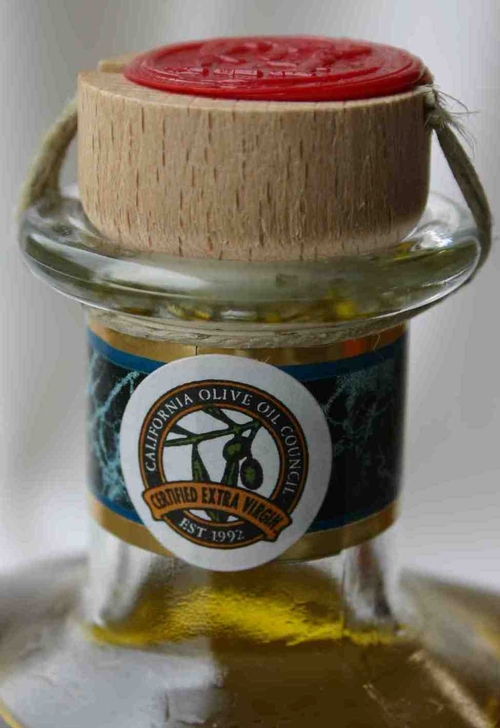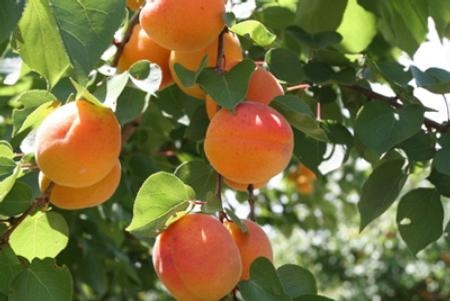
Posts Tagged: flavor
Like to Know More About Honey?
Would you like to know more about honey? You're in luck. The UC Davis Honey and Pollination...

Honey bee on honeycomb. (Photo by Kathy Keatley Garvey)
A Taste of Honey
Honey connoisseur Amina Harris, director of the UC Davis Honey and Pollination Center, opens...

Jar of lavender honey rests next to the UC Davis Honey and Pollination Center's Honey Flavor Wheel. (Photo by Kathy Keatley Garvey)

The jar of lavender honey, "miel de lavande," is from France. (Photo by Kathy Keatley Garvey)

Amina Harris sniffs the aroma. (Photo by Kathy Keatley Garvey)
Honey! I Hardly Know You!
Every time I see a golden jar of honey, I'm reminded of the Cordovan bee (Italian subspecies) that...

A golden honey bee (Cordovan of the Italian subspecies) nectaring lavender. (Photo by Kathy Keatley Garvey)

Honey bee sipping nectar from lavender. (Photo by Kathy Keatley Garvey)
Arrival of apricot season
The brief season of apricot harvest is upon us, and many fruit enthusiasts will soon bite into one of these small, delicate, yellowish-orange fruits. I grew up in a San Jose subdivision that was built on an apricot orchard. Each house had 2 or 3 apricot trees left on the lot, and so I have great memories of enjoying them fresh from the tree, still warm from the sun and tartly sweet . But, I have to admit that my favorite form of apricot then and now, are home-dried apricots. They sure were a great treat to find nestled in my trusty red-plaid metal lunchbox in the middle of winter.Apricots have been grown in the fertile crescent of Persia for thousands of years. The colonists brought the apricot to North America, but most of the stock of today’s production comes from seedlings carried by the Franciscan friars who built the missions and brought much of Spain’s agriculture to California.
In recent years I have heard many disappointed comments at that first bite of a fresh apricot, and I was curious to check with University of California pomologists and USDA Agricultural Research Station specialists to see what progress was being made in bringing more flavorful apricots to consumers. Five different pomologists indicated that market produce buyers tend to primarily value color, size and firmness over the flavor of apricots. The earlier the produce buyers can get them into the grocery store, the more highly they are valued, so they are often harvested before the fruit’s flavor has a chance to develop. The experts I checked with all said they NEVER bought apricots anywhere except a farmer’s market or roadside stand.
The varieties most commonly grown in California are “Patterson”, “Tilton” and “Apache,” and they are selected by growers because of their early harvest dates, large size, attractive color, longer shelf life, and their ability to be used for either fresh or canning applications. Tom Gradziel, a UC Davis professor of genetics and breeding of the Prunus species said, “In the Central Valley, most apricots are still going for processing. Therefore a dual market (processing or fresh) variety such as Patterson is often preferred. It has excellent color, size, and firmness, but tastes like cardboard."
The varieties that the pomologists included in their list of favorites are “Royal Blenheim,” “Robada,” “Katy,” “Primarosa” and “Derby.” Craig Ledbetter, a geneticist working with apricot breeding at the Parlier USDA Agricultural Research Service Center said, “We hear so much about flavor, but I don’t think flavor will be coming to the grocery stores unless in the form of overripe fruit. Here we breed for a sugar/acid balance. We have many breeding selections that taste absolutely fabulous, but are a bit smaller than growers desire. Honestly, they don’t even want to look at ‘small’ fruit. It is a pity!”
Selecting apricots. Apricots do not develop more flavor after they are picked, so select fruit that are completely yellow, deepening toward orange. The subtle, sweet scent of apricot is a good indicator that the inside will taste just as good.
Storing apricots. Keep them on the counter if you will eat them within 2 to 3 days, otherwise store ripe apricots in the refrigerator in a perforated plastic bag.
How to enjoy apricots. Apricots have a pit in the center that is easily separated from the flesh. After washing the fruit, cut in half along the seam and remove the pit. Enjoy the whole fruit, or prepare in tarts, breads, jams, glazes for meats, salsa, or dry them in a dehydrator.
Apricot Tart
Pastry.
1 ¼ c. all-purpose flour
½ tsp. salt
1 Tbls. granulated sugar
½ tsp. almond flavoring (optional)
½ c. unsalted butter, chilled
2 Tbls. Ice water
Apricot filling.
½ c. granulated sugar (or less if the apricots are sweet)
1 Tbls. cornstarch
Dash of salt
1 ½ lbs. (or 10 medium-large) fresh, ripe apricots, pitted and sliced into 1/4” slices
Place sugar, cornstarch and salt into a bowl and stir well, add sliced apricots and toss gently.
Remove pastry from the refrigerator, place apricot filling in the center of the pastry, leaving a 2” border around the edge. Gently fold the pastry border up on top of the apricots, folding the pastry up around the outside edges of the fruit and pinching folds to form a round tart. Seal any cracks in the sides and bottom of the pastry so the juice doesn’t leak out on the baking sheet. Leave the fruit showing in the center of the pastry. Sprinkle with a handful of sliced almonds if desired.
Bake at 375 degrees F for 40-45 minutes, or until golden brown.
Excellent served with vanilla ice cream.
University of California Resources:
- Recommendations for Maintaining Postharvest Quality of Apricots
- Storing Fresh Fruits and Vegetables for Better Taste
- Apricot Information: Fruit & Nut Research and Information Center
'Extra virgin' olive oil: What is it and why does it matter?
Dipping fresh bread into olive oil has become a popular alternative to coating it with butter. Olive oil consists of 85 percent unsaturated fats, and when substituted for saturated fat in the diet can promote ”good” cholesterol (high density lipoprotein or HDL), reducing risk of coronary artery disease.
Some olive oils are more beneficial than others. "Extra virgin" olive oil (EVOO), for instance, is extracted from the olive fruit without using heat or chemical solvents. This mechanical process retains the highest amount of natural “phenolic compounds” — antioxidants and anti-inflammatory agents. Such compounds both retard oxidation in the olive oil (keeping it fresh and preventing rancidity) and confer health benefits.

Miller's diagram (above) depicts the fatty acid content of olive oil. PUFA is polyunsaturated fatty acids.
"Antioxidants combat cell and tissue damage due to oxidation, and anti-inflammatory agents reduce inflammation throughout the body. Inflammation can lead to an array of diseases (arthritis, coronary artery disease and more),” said Amy Myrdal Miller, registered dietitian and a program director at The Culinary Institute of America.
When oils are 'refined,' heat or chemical solvents strip away phenolic compounds; the result is often a bland flavor. Mechanically extracted "extra-virgin" oils retain aromatic components. Pungent, peppery and sometimes bitter notes signal that an oil contains phenolics.
The growth of premium olive oil production in California has its roots in 1997, when UC Cooperative Extension Sonoma County Advisor Paul Vossen started the first olive oil taste panel in California to help producers improve oil quality using sensory analysis. (See the January 2011 California Agriculture.)
When it comes to detecting positive and negative attributes of olive oil, human tasters are superior to current chemical analytical methods. Standards to define "extra-virgin" and other grades of oil include both sensory and laboratory measures. The International Olive Council's (IOC) narrow definition specifies that EVOO must show no evidence of heat or chemical solvents. It must have zero median "defects" (as judged by trained taste panels) and more than zero median fruitiness. It must meet requirements for low levels of free fatty acids (too many of these signal degradation) and peroxide levels (a sign of oxidation).
This definition has been adopted by the U.S. Department of Agriculture (USDA) and the states of California, Connecticut and Oregon. Beginning on Oct. 24 of 2010, it became part of new USDA standards for olive oil labeling, which also define "U.S. Virgin," "U.S. Refined" and other grades. Although the standards are voluntary, any manufacturer using this terminology on its label could be held to truth-in-labeling laws.
While the ultimate impact of the new USDA standards will take time, consumers can learn to identify flavor attributes of California olive oils by participating in tastings at vendors that feature artisan products. Also, the

However, the array of olive oils now available at supermarkets can be daunting, and "extra virgin" on the label can be misleading. The UC Davis Olive Center reported in July 2010 that their samples from Sacramento, San Francisco and Los Angeles supermarkets revealed 69 percent of imported EVOO and 10 percent of California olive oil samples labeled as EVOO failed to meet International Olive Council (IOC)/USDA sensory standards for extra virgin olive oil.
Once you identify your favorite olive oil, it should be stored in a cool, dark environment, like a kitchen cabinet removed from the stove, according to Alexandra Vicenik Devarenne, freelance olive oil consultant in Sonoma County. Fluctuations in temperature and light affect the integrity of the health-promoting phenols in extra virgin olive oil.
“When people find out about phenolics and the effects of heat on olive oil, they may question whether it is safe and okay to cook with extra virgin olive oil,” she says. “The heat will destroy some of the health-promoting phenols in the oil, which will change the flavor. The longer the oil is exposed to heat, and the higher the heat, the more phenols will be destroyed.
“However, sautéing in extra virgin olive oil for 5 to 10 minutes over medium heat will have minimal effects on phenols and flavor.”

See more tips on storing and cooking with olive oil.


